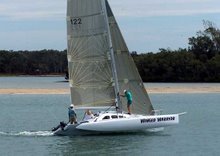
Aft cocpitseat and stern plate fitted, it is a strait forward job, note I cut down the formframes no. 12, 13 ,14 all that was above hull, I should have done that on the first half, just a mistake when making the formframes.

I fitted all the HD inserts now, I stick to Ian Farriers setup, it looks fine and I see no reason to chance it. One thing that might be of interest is how far in/out the jib track is placed. It can only be seen when sailing. I think that if you try to pinch the boat it will go higher to the wind but much slower.

The remains from 12 mm foam, both deck halfs, pile on left to the bin, pile on right might get another chance, as some places you will need small pieces.
I think the waste procentage is pretty good, it must be 1-2 %, and it please me since this Corecell foam is quite expensive ( 12 mm x 122 X 244 cm is 103 € that is 34.50 € /m2). High density foam is
ridiculous expensive, it is 127.50 € / m2, and the smallest sheet you can get is 0.9 x 183 cm.
 Mixing fairing compound for beams.
Mixing fairing compound for beams. First coat applyed, and sanded, it is not an easy job fairing beams, and the netrails does not make it any easier. Apart from looking nice I dont believe there is any weight saving at all, originally Farrier calls for small alu plates inside beam for tapping screws into and U shaped fittings on outside. If I had know how much work went into fitting and fairing netrails I might have chosen U fittings. Buying premade beams may be expensive, but it is a huge time saver, do it if they are available for you prefered boat (F22 and F32). Apart from that it is quite fun to make the beams, such a complex part of the boat and folding system.
First coat applyed, and sanded, it is not an easy job fairing beams, and the netrails does not make it any easier. Apart from looking nice I dont believe there is any weight saving at all, originally Farrier calls for small alu plates inside beam for tapping screws into and U shaped fittings on outside. If I had know how much work went into fitting and fairing netrails I might have chosen U fittings. Buying premade beams may be expensive, but it is a huge time saver, do it if they are available for you prefered boat (F22 and F32). Apart from that it is quite fun to make the beams, such a complex part of the boat and folding system. All set for vacuumbagging deck. I prepare everything as much as I can, cut all material, laminate, reinforments, peelply, slipfilm and bleeder (as an experiment I have sprayglued film and bleeder together so I can apply them as one, more on this later). Vacuumtape all around and bag sealed to one side with airline attached, so work is minimised once resin is mixed. Not that I am in a hurry, I use extra slow hardener, but if something is wrong I got time to fix it, typically a leak in the foam.
All set for vacuumbagging deck. I prepare everything as much as I can, cut all material, laminate, reinforments, peelply, slipfilm and bleeder (as an experiment I have sprayglued film and bleeder together so I can apply them as one, more on this later). Vacuumtape all around and bag sealed to one side with airline attached, so work is minimised once resin is mixed. Not that I am in a hurry, I use extra slow hardener, but if something is wrong I got time to fix it, typically a leak in the foam.



































